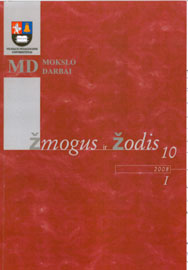Priesagos -inis, -ė būdvardžių kirčiavimas pietinių pietų aukštaičių šnektose
Adjectives with the suffix –inis, -ė in the southern sub-dialects of southern highlanders
Author(s): Vilija Lazauskaitė-RagaišienėSubject(s): Language and Literature Studies
Published by: Vytauto Didžiojo Universitetas
Keywords: adjective; suffixal derivative; base word; semantics; accentuation class; accentuation variant.
Summary/Abstract: The paper aims at describing the usage, area of use and accentuation of adjectives formed with the suffix -inis, -ė (e. g. lininis, -ė) in the southern dialects of southern highlanders. The data for the present research covers about a hundred and a half derivatives of the above pattern. They were mainly collected from the voice recordings of 2003-2007 and are stored in the Archive of Dialects of the Institute of the Lithuanian Language. In the area of dialects under investigation the bulk of the recorded -inis, -ė adjectival derivatives are of nominal origin referring to the material of which or with the help of which something has been made, e. g. kruopinė kõšė. In most cases the accentuation of -inis, -ė adjectives in the southern dialects of southern highlanders is directly related to the accentuation of the base word and is determined by its accentuation power. If the base word is of the third or fourth accentuation class, its derivative tends to adopt the suffixal accentuation pattern, e. g. arklinis, -ė (: arklỹs, 3rd class), laukinis, -ė (: laũkas, 4th class). Adjectives derived from nouns of the 1st and 2nd accentuation class follow two accentuation patterns: the stress falls either on the root (e. g. pieninis, -ė (: pienas, 1st class), rañkinis, -ė (: rankà, 2nd class) or on the suffix, e. g. drobinis, -ė (: dróbė, 1st class), cukrinis, -ė (: cùkrus 2nd class). A tendency to accentuate the latter derivatives according to the second accentuation class is related to the meaning of adjectives (those referring to materials tend to adopt the stress on the suffix, independently of the accentuation paradigm of the base word) and can be explained by the accentuation analogy of other -inis, -ė derivatives and the accentuation variability of the base words or their forms.
Journal: Žmogus ir žodis
- Issue Year: 10/2008
- Issue No: 1
- Page Range: 94-104
- Page Count: 11
- Language: Lithuanian

